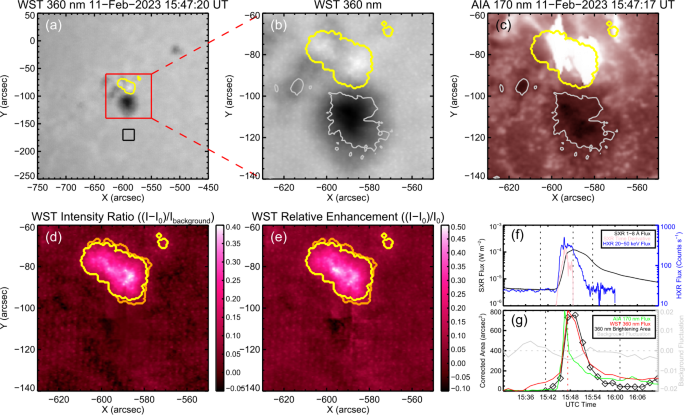A Statistical Study of Solar White-Light Flares Observed by the White-Light Solar Telescope of the Lyman-Alpha Solar Telescope on the Advanced Space-Based Solar Observatory (ASO-S/LST/WST) at 360 nm
Abstract
Solar white-light flares (WLFs) are those accompanied by brightenings in the optical continuum or integrated light. The White-light Solar Telescope (WST), as an instrument of the Lyman-alpha Solar Telescope (LST) on the Advanced Space-based Solar Observatory (ASO-S), provides continuous solar full-disk images at 360 nm, which can be used to study WLFs. We analyze 205 major flares above M1.0 from October 2022 to May 2023 and identify 49 WLFs at 360 nm from WST observations, i.e. with an occurrence rate of 23.9%. The percentages of WLFs for M1 – M4 (31 out of 180), M5 – M9 (11 out of 18), and above X1 (7 for all) flares are 17.2%, 61.1%, and 100%, respectively, namely the larger the flares, the more likely they are WLFs at 360 nm. We further analyze 39 WLFs among the identified WLFs and investigate their properties such as white-light enhancement, duration, and brightening area. It is found that the relative enhancement of the white-light emission at 360 nm is mostly (>90%) less than 30% and the mean enhancement is 19.4%. The WLFs’ duration at 360 nm is mostly (>80%) less than 20 minutes and its mean is 10.3 minutes. The brightening area at 360 nm is mostly (>75%) less than 500 arcsecond2 and the median value is 225. We find that there exist good correlations between the white-light enhancement/duration/area and the peak soft X-ray (SXR) flux of the flare, with correlation coefficients of 0.68, 0.58, and 0.80, respectively. In addition, the white-light emission in most WLFs peaks around the same time as the temporal derivative of SXR flux as well as the hard X-ray emission at 20 – 50 keV, indicative of the Neupert effect. It is also found that the limb WLFs are more likely to have a greater enhancement, which is consistent with numerical simulations.


 求助内容:
求助内容: 应助结果提醒方式:
应助结果提醒方式:


